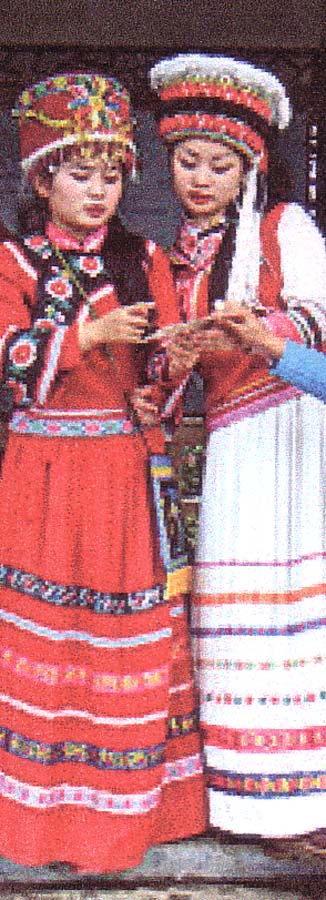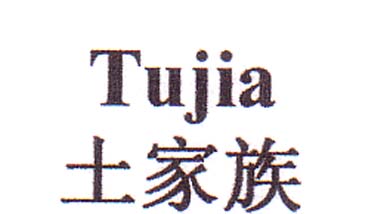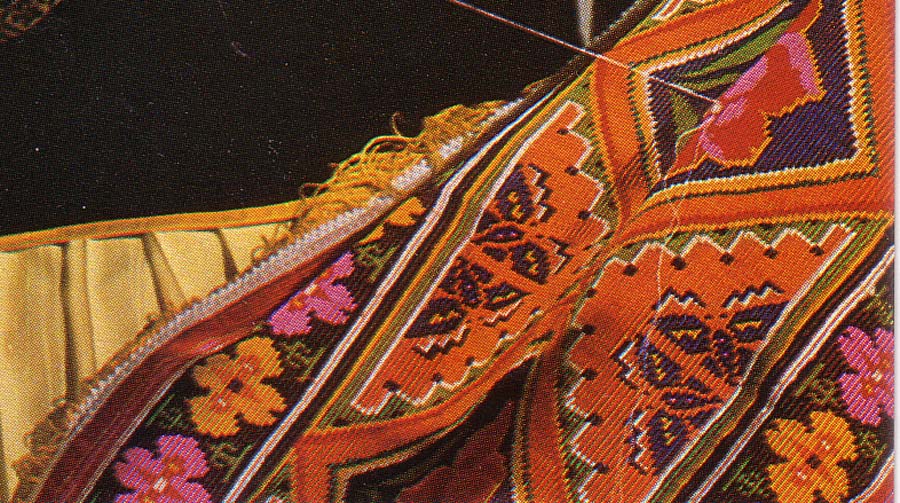
| What is Flavor and Fortune? |
| How do I subscribe? |
| How do I get past issues? |
| How do I advertise? |
| How do I contact the editor? |
Read 13070935 times
Connect me to:
| Home |
| Articles |
| Book reviews |
| Letters to the Editor |
| Newmans News and Notes |
| Recipes |
| Restaurant reviews |
| Article Index (all years, slow) |
| List of Article Years |
| Article Index (2025) |
| Article Index (last 2 years) |
| Things others say |
| Related Links |
| Log In... |
| Authors |
| Categories & Topics |
Tujia: China's 7th Largest Minority
| by Jacqueline M. Newman |
Chinese Ethnic Minorities and Their Foods
Spring Volume: 2014 Issue: 21(1) page(s): 5, 6, and 8

 Not counting the Han, China's majority population, the number seven is correct as this population has less people than the Zhuang, Hui, Manchu, Uyghur, Miao, and Yi minority populations in China determined in China’s 2010 census report. To date, this magazine has reported on close to a dozen minority groups; to read them, check the index listings of articles to date.
Not counting the Han, China's majority population, the number seven is correct as this population has less people than the Zhuang, Hui, Manchu, Uyghur, Miao, and Yi minority populations in China determined in China’s 2010 census report. To date, this magazine has reported on close to a dozen minority groups; to read them, check the index listings of articles to date.
Tujia people live mostly in China's Hunan and Enshui prefectures; they are in the Hubei Province and in the Wuling mountain regions in the western part of the Hunan, Hubei, Guizhou, and the Chongqing Provinces. All of these are in central China. Each of these provinces are where more than one million Tujianese live. There are also more than one hundred thousand of them in the western part of the Guangdong Province and less than half that number in the Zhejiang, Sichuan, and Fujian Provinces. All together, the 2000 Chinese census reported twenty-eight thousand more than eight million Tujianese in China. Current data indicates some half million more since that date.
This population is an ancient group that traces their ancestry back more than twelve centuries, perhaps longer to the ancient Ba Kingdom in and around Chongqing. One source said they are two and a half thousand years older than that. Only officially recognized by the current government in 1957, they did become one of the fifty-five minority populations in 1963.
Most were and still are farmers, almost all were and still are greatly influenced by the Han majority population. They have lived in close proximity with the Han for many hundreds of years. Saying they are descended from Ba people, they were once called Wuling Barbarians.
Like many other ethnic populations in China, they prefer using another name, one that loosely translates to 'native dwellers,' 'locals,' 'natives,' or 'aborigines.' They prefer being called 'Tuding' people. Among themselves, they use 'biska' or 'bizica,' and not Tujia.
With the help of the central government, two main areas were established, two Tujia-Miao Autonomous Prefectures that are in the Western Hunan and Western Hubei Provinces. In addition, they live in a literal handful of other autonomous counties, namely Youyang, Xiushan, Shizhu, Qianjiang, and Pengshui.
Among themselves, these people speak their own Tujia language which is a dialect of Chinese and part of the Tibetan-Burmese branch of the Sino-Tibetan language group. Some also speak Miao. With compulsory education, all young folk speak Mandarin, so most are bi-lingual.
 Known for their singing and dancing and their gorgeous embroidery, these people practice ancestor worship and worship nature and totems. Most consider themselves descendants of the white tiger totem, a few in western Hunan worship a turtle totem.
Known for their singing and dancing and their gorgeous embroidery, these people practice ancestor worship and worship nature and totems. Most consider themselves descendants of the white tiger totem, a few in western Hunan worship a turtle totem.
Their chiefs were much appreciated during the Ming Dynasty (1368 - 1644) as they marshaled fierce fighters and had them employed by the emperor to suppress revolts in other minority populations. They kept down outside invaders, particularly the Japanese.
Their women were and still are known for their embroidery; they wear these with gold, silver, and jade jewelry which they like in their ears and around their necks. At festivals, they show it off, particularly at the Gannain, Gnome, and Ox King Festivals.
The first of the special days of these festivals are at the end of December in their Lunar New Year and these are a couple of days longer than the Chinese Spring Festival. This holiday celebrates defeating Japanese pirates. As ancestor worshipers, on this day they pray to them for health and future victories. The second festival above, is in early February, also on the Lunar calendar. On that day, they offer sacrifices to the land and their Gnome for a good harvest. The third special Tujia festival day above is in April on their Lunar calendar. A king once saved their ancestors and they honor all oxen that day and sacrifice a pig to this god treating all relatives and friends to a feast using meat as the main festival food. As this in their 'ox day,' they treat all animals well this day, and they feed them the best foods available. Usually, their animals live on the ground floor of their hanging village homes, but on this day, they move down and keep them company feeding them all day long. They share their sour-salty-spicy foods with them and all their vegetables with them on this day.
This day and almost every day, they eat lots of cured pork, cured chicken, cured duck, and cured fish. Any other animal flesh available they prefer cured, too. They flavor their cured foods with Sichuan peppercorns, salt, black pepper, and other spices; and they leave them soaking in these spices for two weeks, then they smoke them over pine branches, rice husks, charcoal, and orange peel for a like amount of time. After these two weeks, they fry them with lots of garlic, then steam them with sticky rice, or they roast them with green peppercorns or they stew them with fermented bean curd. They like these tastes together. Clearly, this is a many-day time-consuming process. They serve any or all of these meats thermally hot and quite spicy, then eat them with many different pickled vegetables. With them, they drink lots of sweet alcoholic beverages, the favorite is 'Za Wine' that is fermented from a combination of sweet rice, corn, wheat, and sorghum; second best is a rice wine. They drink both, tea, and tea oil drinks.
The staples of the Tujai are rice and corn, sweet potatoes too. They eat lots of them, sometimes mixed with chili peppers and/or fermented bean curd. They also adore and can have them with fish head soup made sour and spicy, and often add peanuts to it. Another soup liked by the Tujia is black-bone chicken soup made with this type of chicken, cabbage that is pickled of course, radishes, shallots, and cured pork. Another special dish is pigs blood solidified with doufu.
Overall, the main fat the Tujai use for cooking Is lard, but it can be mixed with vegetable oil. After a main meal, they end their meal with rice cakes made with glutinous rice, these are frequently made with Chinese gooseberries.
Another famous dish sounds like one many know that is sometimes called Kung Pao Chicken. But theirs is spicy, sour, and salty, and served with pickled potatoes. A famous snack they adore is chicken feet made pickled and spicy. Another is their pan-fried dumplings filled with spicy vegetables and cured meat, the vegetables in this dough item are mainly pickled cabbage and carrots.
Many foods and festivals sound or look the same but are not. One example is their Lunar New Year. This holiday begins on the second to last day of the old year and continues through Lantern Festival. Another in the food category, is that they use mixed starches. They like sweet potatoes mixed with wheat, rice, and corn, and use this mixture as one of their staples.
Another item of difference are their marriage behaviors. Theirs has five steps. The first is the proposal done by the go-between who arrives at the future bride’s home with cured meat. Next a friend of the future groom’s family will bring more cured meat to the future bride’s family. If the wedding is a go and her parents agree, her family will tell that person the bride’s day and date of birth, the hour, too. The next process is for the groom-to-be to bring a ham and a pig’s tail. On his second visit which is the fourth step, he will tell her family the date and time of the wedding. Step five is when he comes, arriving early on the wedding morning to fetch his bride.
The Tujia used to marry their cousins, also to choose their own mates. These practices are diminishing, almost gone; the opposite of many young people in China today. They also used to always serve their cured meats in chunks. Now, they cut them in small pieces so they will cook faster. With mst men and women working, this does save time.
Brides used to cry for some twenty days before the wedding, now that behavior only happens on the way to the groom's house. Also, they used to train young girls at age ten or so how to cry, but that, too, seems to be an item of the past.
What has not changed is their doing a hand-waving dance with some seventy specific movements. It was and still is called the baishou dance. Usually, done twice a year, once on the ninth day of the first lunar month, the second time at another festival, some still call it a wannian celebration. Also, still practiced is men giving the matchmaker meat cured made by his family, and a meal served to him and his escorts when he comes to fetch his bride. Still popular, too, is the bride returning to her parents home with her new husband three days after the wedding. Also, three days before it, his family is still sending hers meat, wine, and wedding clothes three days before the event. Also practiced, when she does first arrive at his home, they two principals race to the nuptial chamber, the winner tells all who will rule the roost.

Copyright © 1994-2025 by ISACC, all rights reserved
Address
3 Jefferson Ferry Drive
S. Setauket NY 11720